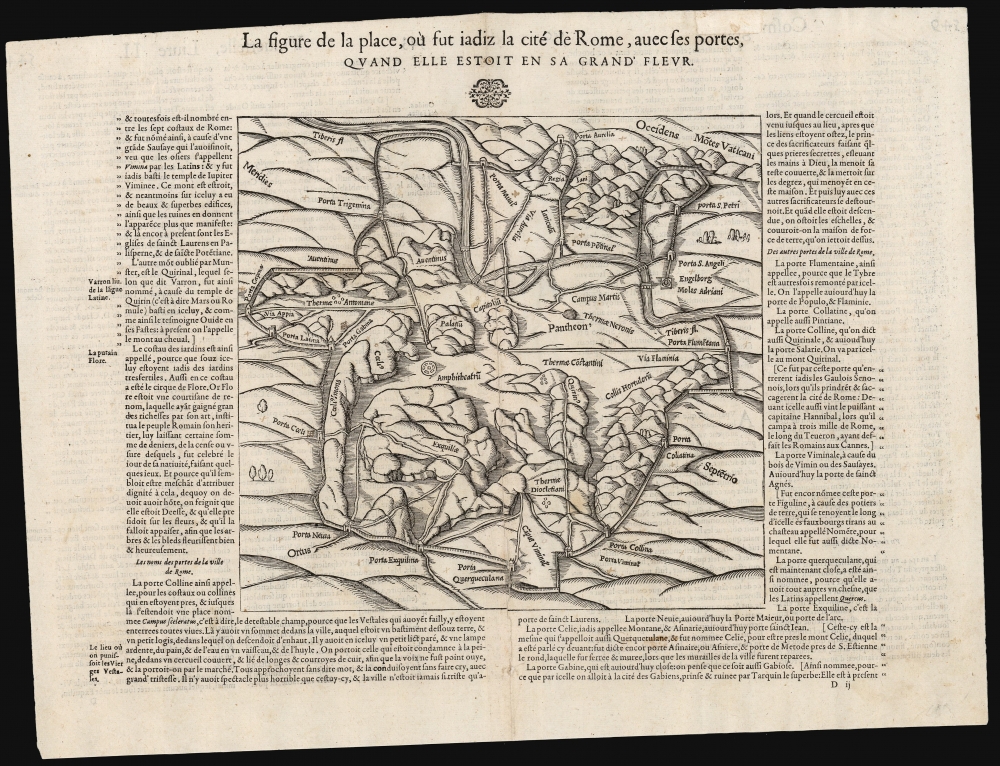1575 Belleforest Map of Ancient Rome and her Monuments
Rome-belleforest-1575
Title
1575 (undated) 11 x 13.5 in (27.94 x 34.29 cm)
Description
The Great French Translation of Cosmographia
This woodcut appeared in Belleforest's translation of Münster's Cosmography. Münster's publisher, Heinric Petri, produced a French edition of the book in 1552 and a further French edition appeared in 1568. Nonetheless, Belleforest, a prolific writer, historian, and accomplished translator, appears to have been unsatisfied with it. His own edition, produced in 1575, went beyond translation, introducing numerous corrections to the text where Münster omitted details or made mistakes. He also added many new woodcuts to illustrate the work. Some of these replaced Münster's original maps with new ones based on more up-to-date geographic sources, such as Ortelius, and Braun and Hogenberg. These are often more desirable than the originals upon which they are based, due both to their rarity as well as their beauty.The present map copies an original excecuted by formschneider Heinrich Holzmüller for inclusion in the expanded 1550 edition of Münster's Cosmographia, and which would remain in that work as late as 1598. Belleforest's version is a faithful copy, but is easily distinguished by the absence of Holzmüller's monogram in the lower left.
Publication History and Census
This map was produced for inclusion in Belleforest's 1575 La Cosmographie Universelle, which was published in a single edition. About twenty examples of the book are listed in institutional collections. Only one example of this Belleforest edition of the separate map appears in OCLC, in the collection of the Biblioteca Nacional de Espana.CartographerS
François de Belleforest (1530 – 1 January 1583) was a French author, poet and translator. Born poor and orphaned young, he nevertheless found his way into the court of Marguerite of Navarre, and traveled throughout France. He came to Paris, where he interacted with the writers of that generation. and then to Paris where he came into contact with members of the young literary generation. He wrote prolifically - more than fifty works - but he is best known in cartographic circles for his cosmographical and historical writing, as well as his translations. His 1575 translation of Sebastian Münster's Cosmographia resulted in a more beautifully illustrated work than its original, replacing its now out-of-date with gorgeous woodcut renditions of maps based on Ortelius, Braun and Hogenberg, and other courant sources. He rose swiftly despite dying relatively young: from his impoverished beginnings, by 1568 he had become historiographer to the king. More by this mapmaker...
Sebastian Münster (January 20, 1488 - May 26, 1552), was a German cartographer, cosmographer, Hebrew scholar and humanist. He was born at Ingelheim near Mainz, the son of Andreas Munster. He completed his studies at the Eberhard-Karls-Universität Tübingen in 1518, after which he was appointed to the University of Basel in 1527. As Professor of Hebrew, he edited the Hebrew Bible, accompanied by a Latin translation. In 1540 he published a Latin edition of Ptolemy's Geographia, which presented the ancient cartographer's 2nd century geographical data supplemented systematically with maps of the modern world. This was followed by what can be considered his principal work, the Cosmographia. First issued in 1544, this was the earliest German description of the modern world. It would become the go-to book for any literate layperson who wished to know about anywhere that was further than a day's journey from home. In preparation for his work on Cosmographia, Münster reached out to humanists around Europe and especially within the Holy Roman Empire, enlisting colleagues to provide him with up-to-date maps and views of their countries and cities, with the result that the book contains a disproportionate number of maps providing the first modern depictions of the areas they depict. Münster, as a religious man, was not producing a travel guide. Just as his work in ancient languages was intended to provide his students with as direct a connection as possible to scriptural revelation, his object in producing Cosmographia was to provide the reader with a description of all of creation: a further means of gaining revelation. The book, unsurprisingly, proved popular and was reissued in numerous editions and languages including Latin, French, Italian, and Czech. The last German edition was published in 1628, long after Münster's death of the plague in 1552. Cosmographia was one of the most successful and popular books of the 16th century, passing through 24 editions between 1544 and 1628. This success was due in part to its fascinating woodcuts (some by Hans Holbein the Younger, Urs Graf, Hans Rudolph Manuel Deutsch, and David Kandel). Münster's work was highly influential in reviving classical geography in 16th century Europe, and providing the intellectual foundations for the production of later compilations of cartographic work, such as Ortelius' Theatrum Orbis Terrarum Münster's output includes a small format 1536 map of Europe; the 1532 Grynaeus map of the world is also attributed to him. His non-geographical output includes Dictionarium trilingue in Latin, Greek, and Hebrew, and his 1537 Hebrew Gospel of Matthew. Most of Munster's work was published by his stepson, Heinrich Petri (Henricus Petrus), and his son Sebastian Henric Petri. Learn More...

